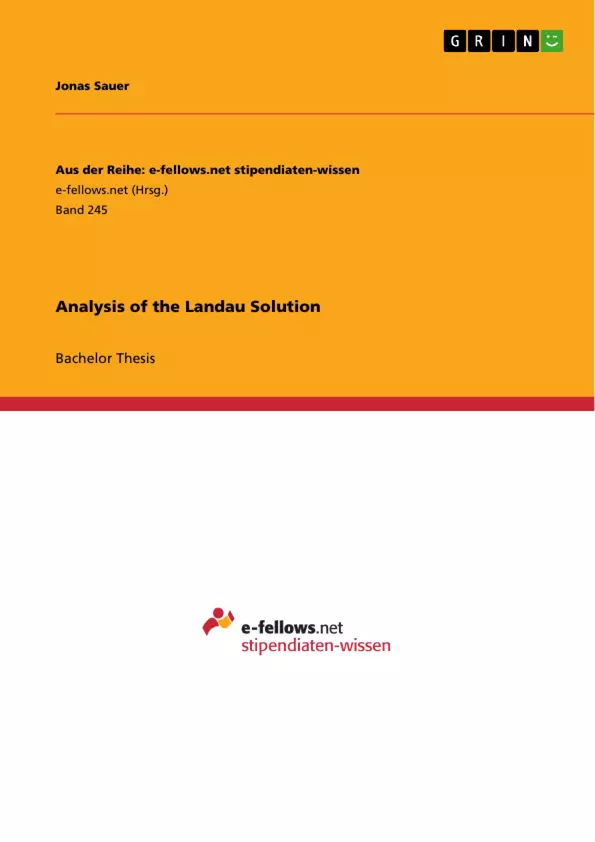In 1944 Lev D. Landau found a non-trivial solution to a stationary Navier-Stokes flow on R³, which was symmetric around some axis and fulfilled the condition, that the velocity decayed linearly
and the pressure quadratically in |x|, depending on a parameter -1 < d < 1 uniquely determined by the force acting on the fluid.
Landau was examinating this flow model when considering the following physical experiment. Imagine a thin pipe in a fluid without any boundary conditions. The fluid is driven by a small jet outflowing the pipe. If one looks at the limit case, where the diameter of the pipe shrinks to zero, there is no force acting on the fluid on R³. Nevertheless, if one wants to describe the physical behaviour of the fluid completely, one has to take into account the force acting at the origin, i.e. at the orifice of the pipe. Therefore, one
has to extend the solution in a suitable manner to the whole space R³. This can be done if one admits also weak solutions in the space of distributions.
When looking at the solutions found by Landau, it seems quite natural to ask, if there are also reasonable physical interpretations for the case |d| greater or equal to 1. Therefore we first derive Landau’s solution with the assumptions posed in the beginning, following an ansatz by Batchelor. From there it will be clear, that the
velocity is unbounded on a cone, if |d| > 1. As it turns out, such a modified Landau solution is no longer
a solution to a Navier-Stokes system - clearly not in the classical, but as well neither in the weak nor very
weak sense. If d = ±1, the velocity will be unbounded on the half line x1 = x2 = 0, ±x3 ≥ 0.
In this case, we have a bit more insight in the behaviour of the modified Landau solution, yet still no physically reasonable interpretation can be given in the whole space R³. In any case, one can consider modified Landau solutions to be solutions in certain subsets of R³, where they yield some interesting streamline plots, which are also provided in this thesis. Furthermore, we give an overview over known results concerning the Landau solution.
Inhaltsverzeichnis (Table of Contents)
- Introduction
- Preliminaries
- The Transport Theorem
- Governing equations of fluid dynamics
- Concepts of a solution
- Analysis of the classical case
- The classical Landau solution
- Characterisation and approximation of solutions by the Landau solution
- Analysis of the modified Landau solution
- The critical Landau solution
- The supercritical Landau solution
- Summary and outlook
- Appendix
- Spherical Coordinates
- Euler Theorem on Homogeneous Functions
- The Stereographic Projection
- Distributions
Zielsetzung und Themenschwerpunkte (Objectives and Key Themes)
This bachelor thesis investigates the properties and applications of the Landau solution, a non-trivial solution to the stationary Navier-Stokes equations in three-dimensional space. The work aims to provide a thorough analysis of this solution, exploring its characteristics, limitations, and potential interpretations. The key themes covered include:- The derivation and analysis of the classical Landau solution
- The extension of the concept to modified Landau solutions for different parameter values
- The exploration of the physical relevance and limitations of both classical and modified solutions
- The presentation of streamline plots illustrating the fluid flow patterns associated with these solutions
- The discussion of the mathematical properties and limitations of the Landau solution in the context of Navier-Stokes equations
Zusammenfassung der Kapitel (Chapter Summaries)
The introduction provides an overview of the Landau solution and its historical context, highlighting the motivation behind its study. The chapter also presents a brief description of the physical problem motivating the study, involving a fluid flow through a pipe with a shrinking diameter. The introduction concludes with a note on the notation used throughout the thesis.
The "Preliminaries" chapter covers fundamental concepts and tools used in the analysis of the Landau solution. It introduces the transport theorem, a key mathematical tool used in fluid dynamics, and discusses the governing equations of fluid dynamics, specifically the Navier-Stokes equations. This chapter concludes by defining different types of solutions to the Navier-Stokes equations, setting the stage for the subsequent analysis of the Landau solution.
The chapter "Analysis of the classical case" focuses on the classical Landau solution, providing a detailed derivation and analysis of its properties. The chapter examines its behavior in different regions of space, highlighting its symmetry around an axis and the decay of velocity and pressure. The chapter also investigates the relationship between the classical Landau solution and other solutions to the Navier-Stokes equations.
The chapter "Analysis of the modified Landau solution" extends the analysis to modified versions of the Landau solution, considering cases where the parameter "d" is greater than or equal to 1. This chapter examines the limitations of the modified solutions, their behavior at specific points in space, and the potential physical interpretations. It also explores the streamline plots associated with these modified solutions.
Schlüsselwörter (Keywords)
The main keywords and topics of this thesis include: Landau solution, Navier-Stokes equations, stationary fluid flow, three-dimensional space, symmetry, velocity decay, pressure decay, streamline plots, weak solutions, distributions, critical Landau solution, supercritical Landau solution, physical interpretation.- Citar trabajo
- Jonas Sauer (Autor), 2010, Analysis of the Landau Solution, Múnich, GRIN Verlag, https://www.grin.com/document/179272



